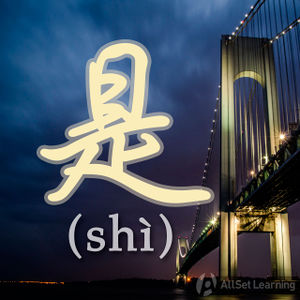Difference between revisions of "Connecting nouns with "shi""
| Line 61: | Line 61: | ||
{{Structure|Basics}} | {{Structure|Basics}} | ||
{{Used for|Referring to the present }} | {{Used for|Referring to the present }} | ||
| + | {{Translation|is}} | ||
| + | {{Translation|be}} | ||
Revision as of 02:44, 19 March 2013
-
Level
-
Similar to
-
Used for
-
Keywords
The verb to be is not used in Chinese the same way as it is in English. In Chinese, 是 is for connecting nouns, and is generally not used with adjectives.
Structure
The structure for connecting nouns with 是 is:
Noun 1 + 是 + Noun 2
This is equivalent to "Noun 1 is Noun 2" in English.
Chinese does not conjugate verbs. That is, the form of the verb is the same no matter who is doing it. In this case, it is always 是 and never changes. As you can see, it's easy to form simple sentences expressing to be in Chinese.
Examples
| Noun 1 | 是 | Noun 2 | Translation | |
|---|---|---|---|---|
| 我 | 是 | 学生 | 。 | I am a student. |
| 她 | 是 | 医生 | 。 | She is a doctor. |
| 他 | 是 | 老师 | 。 | He is a teacher. |
| 这 | 是 | 书 | 。 | This is a book. |
| 那 | 是 | 杯子 | 。 | That is a cup. |



